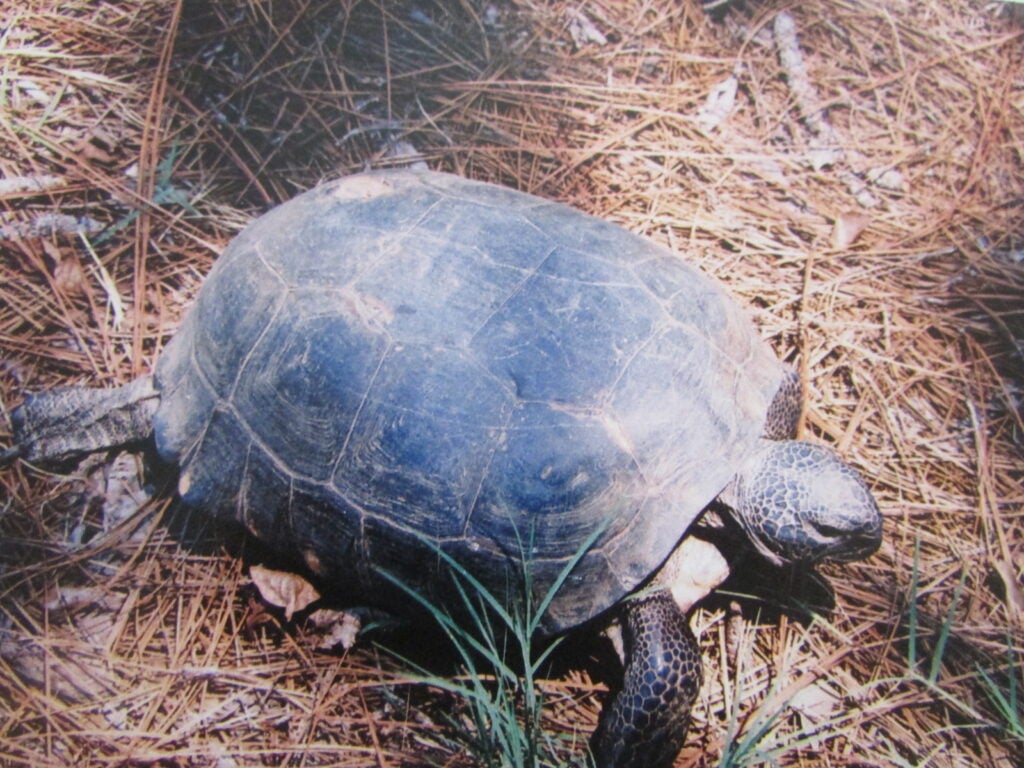Please! Don’t Run Over the Residents
Published 3:14 pm Sunday, February 25, 2024
|
Getting your Trinity Audio player ready...
|
It is not often that we can actually see and touch, a creature that has been around for millions of years, a species that has been in existence long before man began recording history. One can only imagine the instincts and intelligence that this creature possesses and has allowed it to adapt throughout the millennia. For such a creature, man is usually its only enemy and is mostly responsible for their shrinking numbers. Sadly, this, is so with one of our signature animals in southwest Georgia, the gopher tortoise.
Therefore today, we will discuss having love for reptiles. Again, this is a different type of affection and it could mean life or death for an animal that just wants to survive. We can grab a cup of coffee and a cinnamon bun while we ponder how we feel about this animal that does no harm.
The history of this cold-blooded reptile, “gophers polypemus”, is one which started way back in time. They belong to a group of land tortoises that originated in western North America, nearly 60 million years ago. Imagine, this creature, that loves our area, has all of this ancestry which has built his family tree.
At one time, at least 23 species of tortoises were known to have existed in America. Sadly, only four remain today. Three of those species: the Desert Tortoise, the Texas Tortoise and the Bolson Tortoise, are found in the southwestern United States and northern Mexico.
At one time, the Gopher Tortoise lived there, too. However, his ancestors migrated all the way here, to the southeast, millions of years ago. Therefore, he has been here a lot longer than we humans.
Most southeastern Gopher Tortoises are found in north central Florida and southern Georgia. Their numbers have drastically declined along Florida’s south east and the panhandle mostly because of the expansion of folks into these areas.
The life span of the Gopher Tortoise is about 40 to 60 years. They grow slowly, at a rate that varies, according to where they live. For example, in north Florida, the female reaches adulthood at 10 to 15 years of age. But, in southwest Georgia, the female takes 20 years to mature. The female is slightly larger than the male and can grow to be a foot long. You can tell the males from the females by carefully flipping them over. The male has a concave shape to his lower shell, while the females under shell is bowed out making room for her eggs.
The Gopher Tortoise breeds from April to June. The female builds her nest by digging with very wide and strong, flat claws. Her legs are protected by scales so she can dig without injury. The new nest is built close to the one where the female, herself, hatched. Now, she lays one to ten eggs in her nest. They are deposited either in the sand mound in front of the burrow or in another sunny place that is close by. Incubation takes from 90 to 100 days. A female produces one batch of eggs annually and may not want to reproduce every year, especially during those times that are exceptionally dry. The sex of the hatchlings is determined by the temperature of the nest. If it is 85 degrees or higher, the hatchlings will be male. The eggs are vulnerable to predators at this time. Raccoons, foxes and armadillos are just some of the animals that prey on the unhatched eggs of the tortoise.
Also, when hatched, the babies are especially vulnerable to predators until their shells harden, which doesn’t happen until they are about seven years old. Hatchlings will sometimes live in their parents burrow, until they are about 10 to 15 years old. At this time, their shells are about nine inches long. This is when they usually dig a small burrow of their own, close by that of their parents. From then on, adult tortoises have few enemies, other than humans.
The Gopher Tortoise lives in an extensive, underground burrow in dry areas. They love being in sand hills and near long leaf pines, wire grass and berry bushes. They also can live in man-made environments such as pastures and grassy roadsides. All that is needed is well drained, sandy soil for easy digging, lots of plants for food and open sunny areas for nesting and basking, which they love to do.
Periodic, natural fires are important for maintaining the tortoises habitat because they burn away the foliage and allow more sunlight to come in. Today, protected areas use prescribed burning to help maintain the habitat for our shell covered friends.
The Gopher Tortoise’s whole life revolves around his tunnel like burrow, which he digs with his shovel shaped front feet. These burrows can be up to 40 feet in length and 10 feet in depth. They are made this deep, so that the temperature of the burrow remains fairly cool and constant. This provides the tortoise family with shelter during times of extreme temperature, drought and fire.
Each burrow has a single opening and the width of the burrow is usually equal to the length of the tortoise, so he can turn around any place in his home. This means, that if you find a tortoise’s burrow, it is a good indication of the size of the occupant. The burrows are usually easy to spot because of the characteristic mound of lose sand at the entrance. A tortoise’s burrow is usually called home by other animals. This fact has given the Gopher Tortoise the nickname of “Nature’s Landlord”. Burrow inhabitants can include snakes, frogs, and burrowing owls.
The Gopher Tortoise feeds on low growing plants that need abundant sunlight. He eats grasses and fruits like: black berries, and palmetto berries.
The Gopher Tortoise is a legally protected, endangered species which means that it is a crime to hunt and/or kill them. Loss of habitats, diseases and getting run over by uncaring drivers are the main reasons that they are becoming extinct.
We can help this creature to stay around so our grandchildren and great grandchildren can enjoy them by just not running over them. When you see one, and if it is safe, get out of your vehicle and put him on the side of the road for which he was headed. They are a harmless creature, so be kind like Christ would want us to be.
Another reptile which calls our area home is the turtle. They range in size from the 4-inch bog turtles to the 1500-pound leathery turtles of the ocean. They are aquatic and spend their lives in a silent world. They swim amidst the hydrilla, then go under the lily pads and peek out. They are not glamorous by any means, but they are cute, in their own way. Giving yourself a chance to get to know them better and to understand their way life, you’ll find out that, on a primitive level, they will respond to you.
I have a “herd” of turtles which gather at my dock and greet me in the morning. This is because I usually have slice or two of corn bread for them. When I hold the food up, they know, and respond, by gathering in front of me. Dark, hungry eyes watch intently as I break off pieces and toss them into the water for a morning feast. Let the feeding frenzy begin! Now, the clunking and banging of shells can be heard, as they push and shove each other, trying to get the prize that I have offered to them.
The turtle is also an ancient animal that dates back for millions of years, which makes them one of the oldest members of the reptile family. Their family tree dates back farther than even the lizards, the snakes or crocodiles.
As you can imagine, an animal that has such an extensive history has a very large family tree. Historically, they are the symbol of patience and wisdom and are representatives of a long life.
The turtles of the Triassic Period had shells which varied little from those models of today. The main differences are that the ancient shells were not joined together to make one whole unit. Also, ancient turtles had teeth, where now there is just a bony jaw.
One of the oldest turtle fossils was discovered in southwest China. From these remains, anthropologists could see that the turtles could not pull their heads inside their shells like they can now. The turtles that inhabit Lake Seminole are in a species group called “crypto” era. This means that when the turtle draws his neck inside its shell, the neck folds back, along his backbone.
Even though they are mostly in the water, they have very good eyesight and exceptional night vision. They see colors and are able to distinguish a large range of hues. Their hearing and sense of touch are average. Amazingly, their shells are covered with nerve endings, so when you touch it, they can feel it.
About sixty bones support their shell as it protects their vital organs. However, because of their shells, they have poor movement on land. Even though it is cumbersome, this shell not only protects them, it is a vital part of their life. To counteract the lack of movement, they have quick reflexes and a deadly snap. They also can go into their shells, which when mature, the turtle is usually too large for a predators mouth. They also shed scales from their shells as they grow. Small pieces come off when they rub against wood or stones. A turtle cannot breathe like we do, by expanding their chest. Instead, it brings air into its mouth, then pushes this air into the lungs.
With feet that are large and flat, the turtle is a strong swimmer and a good digger. They also are used in their mating ritual. The male, which has extremely long claws, uses them to excite the female and awakens her mating instincts. She will mate with several males before she digs her nest. Therefore, hatchlings can have several fathers.
After mating, the female makes her way to land and digs a hole where she deposits a large number of leathery, elongated eggs. Sometimes, the female will dig several nests to confuse predators. When done, she leaves and does not return. The eggs incubate by themselves, which takes about two months. Then the hatchlings will wiggle out of the nest on their own. If the temperature of the nest was high, the hatchlings will be female. A low temperature means males. Even though they are newly born, their instincts tells them to head straight to the water.
If you are going to pick up a turtle, you need to do it with extreme care. However, it is best not to try to pick up a snapping turtle for he has been known to bite and not let go. You can tell a snapper by his brownish color. Also, he has very long claws on his front feet and also on his webbed back feet. His bottom shell is smaller than his body and the top one has points sticking up. He also has a hooked jaw.
My yard always seems to have a herd of newly hatched babies running towards the water. I usually pick them up and put them on the shore, close to the water, so all they have to do is take a few steps and they are where they want to be. Also, by letting them go a short distance into their destination, you help keep them from predators like crows, from picking them up and eating them. Once in the water, you will be amazed how fast they can take off and swim away. When I see a turtle come onto my shore, I always wonder if that was one of the babies that I helped a couple of years before.
The turtle is now a popular research animal because his internal organs do not age. The lungs and liver and kidneys of a one-hundred-year-old turtle are the same as that of a ten-year-old turtle. Scientist are trying to find out his secret and then share it with humans.
If you find that turtles fascinate you and you want to know more about them. the Riverquarium in Albany is the place to go. Here, you will see all kinds of species of turtles and will learn how to best approach them and take care of them.
I did have a couple of babies that I found in my yard that were being chased by crows. I brought them in and kept them for a while. Yes, I fell in love with them but I realized that they needed to go into the water and do what nature intended. So, on a sunny day, I held them in my hands and took them to the shoreline. I kissed their hard shells and gave them a fond farewell. I did cry as I watched them scurry to the water and dive under. They popped up one time and looked in my direction. Then they left. When I see a turtle coming up on my beach, I often wonder if it is one of “my turtles”, which I named Lilla Mae and Billy Bob.






